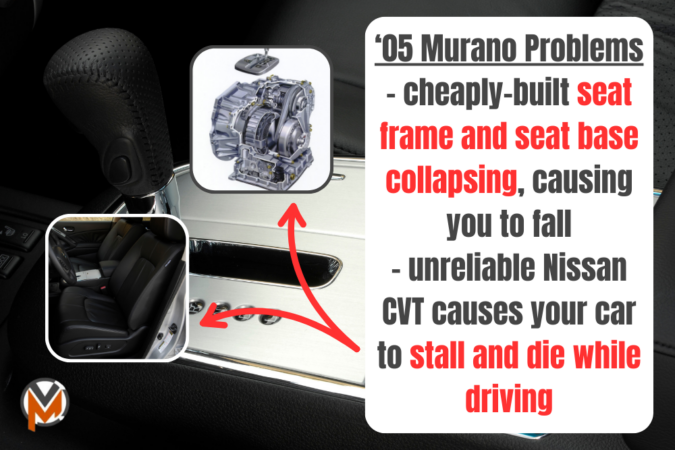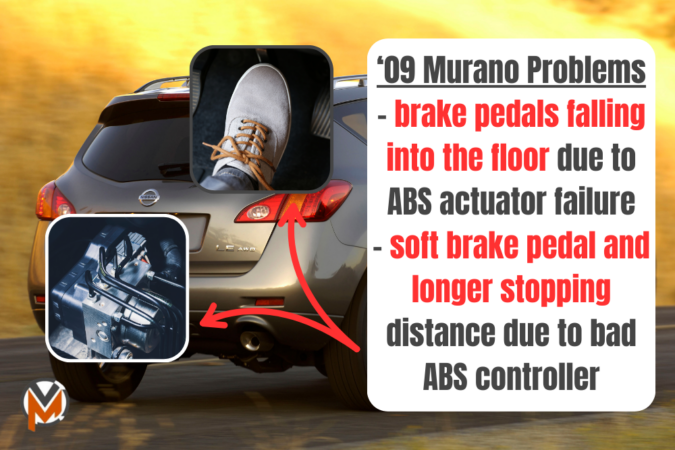The Nissan Murano first came into the market in 2003, and immediately, it quickly became very popular. Widely regarded as one of the first sporty SUVs on the market, the Murano is praised for its powerful engine, driving comfort, and smooth handling. However, it wasn’t free from reliability concerns, hence why it’s vital to understand the worst Nissan Murano years to avoid.
These include the model years 2004, 2005, 2006, 2007, 2009, and 2015. These model years are noteworthy for being some of the more problematic model years, where issues ranging from engine mount failures to Nissan’s infamously unreliable CVT transmission, as well as faults with interior trim falling apart. Granted, most Murano years are pretty reliable.
Which Model Years To Avoid?
Generally speaking, the Nissan Murano is generally quite reliable, barring a few specific model years of the Nissan Murano to avoid. While it’s received praise from consumers and reviewers alike, here are some of the years that ought to be avoided at all costs, given how many problems they have:
2004 Nissan Murano
The second model year of the Nissan Murano, 2004, is commonly considered the worst and most unreliable model year of the Nissan Murano, period. The most common issue suffered by the owners of ’04 Muranos… The door handles. If the door handles aren’t loose and dangling around all the time, owners would often find the door handles falling right off.
This often necessitated that owners need to replace the door handles outright. Oftentimes, however, each door handle would break off more than once, owing to their cheap construction. And, some Muranos had several door handles break apart, too. Other than that, another common design flaw with the 2004 Nissan Murano was outright CVT transmission failure.
Granted, this issue is noted with most other Nissan vehicles using the brand’s CVT, not just the Murano. Owners would note their engine stalling or dying while being driven or sometimes the loss of acceleration, and odd shifting behavior from the gearbox. This was an early sign that the CVT transmission in the Nissan Murano was about to fail, and it was costly to repair.
Usually, owing to how CVTs are made, it’s easier to replace the entire transmission than to rebuild or repair it. This would typically cost owners anywhere from $4,000 to $7,000. This isn’t helped by the fact that these CVTs fail at low mileage, as low as 30,000 miles. As such, owners would sometimes need to replace them several times during the entire ownership period.
2005 Nissan Murano
Once again, just like the ’04 Murano, the 2005 model year Nissan Murano continued to be plagued by woes surrounding the door handles. This time, however, it’s the door locks. The cheaply made, cheaply built, and flimsy door locks would fail. Thus, causing owners to not be able to set up their remote key fobs or keys to properly lock or unlock the doors.
Some owners can’t lock or unlock their doors. Others, on the other hand, would suffer door locks that sporadically worked and didn’t work. The fault was identified to be somewhere within its door lock actuators. Unfortunately, most owners had to pay out of pocket to solve this issue, which costs them anywhere from $200 and up. Even the seats in the Murano break, too.
In particular, the seat base in the ’05 Murano is prone to failing. Therefore, owners would usually find themselves in a situation where the seat collapses or slants sideways. You could probably imagine just how dangerous this can be, as you’re moving around while driving. Nissan would often quote owners upwards of $1,000 to fix this, but DIY fixes are cheaper.
Additionally, another common problem with the 2005 Nissan Murano is, once again, CVT transmission failure. Owners often find themselves stranded, as their cars would stall and die out while they’re driving. This is typically mistakenly identified as an engine issue, but the real underlying fault is Nissan’s then-unreliable CVTs. The only solution is to replace it entirely.
2006 Nissan Murano
A new (model) year brought with it a new set of issues, as 2006 joined the ranks of the Nissan Murano years to avoid at all costs. The most common issue you’ll come across is a leaking power steering system. The inherent flaw was identified to be the high-pressure power steering line. To solve this, owners would have to spend around $400 out of pocket.
Otherwise, you’ll notice symptoms such as loud power steering, or the steering suddenly feeling heavy while you’re driving. Oddly enough, despite how unsafe this is and how frequently it has happened, no recall was ever made. This issue alone is just as bad as the excessive oil consumption problems the ’06 Nissan Murano suffered from. This is partly due to oil leaks.
Nonetheless, oil burning due to cracked piston rings is another typical reason why the ’06 Muranos used more oil than most cars normally do. Unfortunately, by the time this problem was properly identified, many owners were forced to undertake full engine rebuilds. Worse, some had to replace the entire engine, due to excessive wear and tear. But, that’s not all.
One other issue that plagued many owners of the 2006 Nissan Muranos was the faulty transfer cases. This was usually incorrectly diagnosed as transmission problems at first. But, once more in-depth diagnostics were done, it was determined that the transfer case had failed due to faulty seals. Replacing the entire transfer case could cost upward of $3,000.
2007 Nissan Murano
A similar pattern followed through in the next model year, with 2007 Nissan Muranos once again plagued by Nissan’s unreliable CVTs. Complete transmission failure is sadly common, which is a costly repair. A replacement CVT, as is often necessary to solve the issue, could cost you $4,000 to $5,000. Many owners found this out when the CVTs failed while driving.
Most owners experience similar symptoms… Cars stalling or dying on them, hard jerking and shuddering, odd noise while driving, inability to accelerate, gear slippage, and more. Some owners were lucky enough to have this covered under warranty. Most weren’t. Another problem that the ’07 Nissan Muranos had was that same transfer case from earlier.
This time, once again, the transfer case’s oil seal wore out far too rapidly. Consequently, the transfer case would leak out oil, and it would often happen even at low mileage. As those transfer cases normally had more than one seal fail at a time, it’s typically easier to replace the entire transfer case. This isn’t cheap, as it will cost you anywhere from $1,500 to $2,000.
Oh, and the seat base failure from 2005 came back. The ’07 Nissan Murano’s seat base was badly designed. This meant that the support brace and seat anchor, which are made from flimsy metal, would easily fail. The entire seat frame is also known to break, too. Not only is this a safety issue, it’s also costly to fix, with some owners paying $1,000 to fix this.
2009 Nissan Murano
2009 is arguably the most unreliable and problematic model year for the Nissan Murano. The highlight for this model year is soft brake pedals. Owners would, terrifyingly, find their brake pedals falling straight into the floor under hard braking. As you can imagine, this is massively dangerous, with owners nearly rear-ending other cars or getting into an accident.
One easy solution, as some owners found out, was stopping on the side of the road, and pumping the brake pedals to build up pressure. Although, this is meant to be a standby fix for a proper, permanent solution to come by later. The best solution, as many owners found after diagnosing the issue, was to replace the ABS actuator. This is a $2,500 repair job.
Speaking of the anti-lock braking system (ABS), the ’09 Murano’s ABS controller is also prone to failure. This would also cause the brake pedal to drop right into the floor, and at best, the brake pedal would still feel soft, as well as increasing your brake distance. Some owners managed to fix this by replacing the ABS controller or the master cylinder.
Ah, and what would a reliability analysis on a Nissan be without at least mentioning that CVT? The CVT transmission on the ’09 Murano was just as unreliable and problematic as the previous Nissan Murano years to avoid. Once again, rebuilding the CVT isn’t really viable, meaning a full replacement is needed. As with earlier, this would cost $4,000 to $5,000.
2015 Nissan Murano
After some years of dormancy as far as problems go, Nissan was able to fix most of the previous years’ issues on the Murano. However, it reared its head once again when the 2015 model was introduced. Almost all of the major and oft-complained problems for this model year revolved around the CVT transmission. If anything, it proved to be even worse than prior years.
Owners would note symptoms such as hesitation while accelerating, harsh vibrations while driving, and unpleasant jerking as well as shuddering. Other than that, other symptoms include the ’15 Nissan Murano stalling or dying while out on the road, losing power entirely, harshness while coasting, and not being able to downshift.
These problems became especially bad while you’re in bumper-to-bumper traffic, and downright dangerous if you’re going at high speeds. The CVT transmission’s performance, even when it’s in good condition, wasn’t that good either. It would struggle with trying to “hunt” for the right gears. In addition, the gear shifts can sometimes be sluggish or delayed.
Unlike in prior Nissan Murano years to avoid though, the fixes for this supposedly redesigned CVT vary. Some owners were able to fix this for good when their Nissan dealers replaced the valve body. But, for others, a new valve body was only a bandaid fix. The inherent design flaws with the CVT meant a full gearbox replacement ($4,000 to $5,000) was needed.



